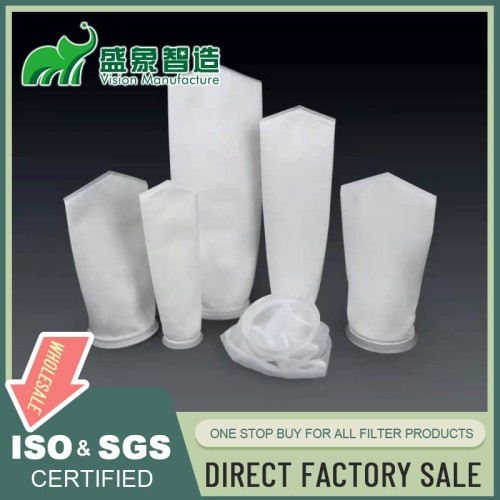
How Do 1.5 Micron Filter Socks Enhance Filtration in Industrial and Commercial Settings?
I. Introduction
In industrial and commercial environments, achieving precise filtration is crucial for maintaining both product quality and environmental standards. Vision Filter's 1.5 micron filter socks are at the forefront of this technology, offering superior filtration capabilities that are essential across various applications. This discussion highlights the significance of 1.5 micron filtration, the innovative technology behind Vision Filter's filter socks, and their pivotal role in diverse industries.
II. Understanding 1.5 Micron Filtration
- Micron Rating Explained: A micron is a unit of measurement that equals one millionth of a meter. A 1.5 micron filter sock is designed to capture extremely fine particles, significantly enhancing clarity and purity in fluids and gases.
- Particle Size Perspective: Particles that are 1.5 microns in size are smaller than the diameter of a human hair and include fine dusts and mists that can be challenging to capture.
- Filtration Efficiency at 1.5 Micron Level: These filter socks are engineered to provide superior filtration efficiency, capturing over 99% of particles at or above 1.5 microns, crucial for maintaining high standards in production environments.
III. Materials and Construction
- Fiber Options: Includes synthetic materials like polyester, polypropylene, and nylon, which offer durability and resistance to a variety of chemical and thermal conditions.
- Manufacturing Techniques: Advanced techniques such as melt-blown, needle-punched, and woven fabrics are used to achieve precise filtration capabilities.
- Surface Treatments and Finishes: Enhancements like glazing or singeing are applied to improve the filter's performance and longevity.
IV. Types of 1.5 Micron Filter Socks
- Felt Filter Socks: Preferred for their depth filtration capability, ideal for capturing solid particles.
- Mesh Filter Socks: Utilized for their inherent strength and uniform pore size, suitable for more abrasive conditions.
- Monofilament vs. Multifilament Construction: Monofilament socks offer excellent strength and uniformity, while multifilament socks are prized for their flexibility and enhanced filtration.
- Specialty Blends for Specific Applications: Customized solutions designed to meet unique industry requirements.
V. Applications Across Industries
1.5 micron filter socks are indispensable in sectors where precision is paramount:
- Chemical Processing: For filtering fine particulates in chemical mixtures.
- Water and Wastewater Treatment: Essential in removing contaminants to meet safety standards.
- Food and Beverage Production: Used in the clarification process to ensure product purity.
- Pharmaceutical Manufacturing: Critical in maintaining sterile environments.
- Oil and Gas Industry: Helps in the filtration of fine impurities from petroleum products.
- Paint and Coatings: Ensures smooth and clean product finishes.
VI. Performance Characteristics
- Flow Rate Capabilities: These filters are designed to maintain optimal flow rates, minimizing process interruptions.
- Dirt-Holding Capacity: Capable of holding a substantial amount of solids before requiring maintenance.
- Pressure Drop Considerations: Engineered to minimize pressure drops, thus enhancing system efficiency.
- Chemical and Temperature Resistance: Built to withstand harsh environments, ensuring durability and consistent performance.
VII. Installation and Maintenance
- Proper Handling and Installation Techniques: Ensures optimal fit and function, crucial for maintaining filtration efficiency.
- Cleaning and Regeneration Methods: Some materials allow for cleaning and reuse, extending the service life.
- Monitoring and Replacement Guidelines: Regular checks and timely replacements are essential to prevent efficiency losses.
VIII. Cost-Benefit Analysis
- Initial Investment vs. Long-term Savings: Evaluates the upfront costs against the operational savings provided by durable, high-efficiency filters.
- Efficiency Improvements in Processes: High-quality filtration leads to better end products and more efficient processes.
- Comparison with Other Filtration Methods: 1.5 micron bags often provide a more targeted and efficient solution compared to other filtration options.
IX. Environmental and Safety Considerations
- Waste Reduction Through Efficient Filtration: Minimizes waste production by effectively capturing contaminants.
- Energy Efficiency in Filtration Processes: Lower energy consumption contributes to environmental sustainability.
- Proper Disposal and Recycling Practices: Addresses environmental concerns associated with filter disposal.
X. Innovations and Future Trends
- Advanced Materials for Enhanced Performance: Ongoing developments aim to enhance filtration efficiency and media life.
- Integration with Smart Monitoring Systems: Future filter systems may include sensors for real-time performance tracking.
- Customization for Specific Industry Needs: Tailored solutions that address unique challenges in various industries.
XI. Case Studies and Success Stories
Examples from various industries demonstrate the effectiveness of 1.5 micron filter socks in enhancing filtration processes, solving specific challenges, and delivering significant improvements in performance and operational efficiency.
XII. Conclusion
The 1.5 micron filter sock is a crucial component in maintaining high standards of purity in many industrial and commercial applications. As technology advances, these filters continue to evolve, offering more effective and sustainable solutions. Staying informed about the latest developments and best practices in filtration technology is essential for any operation that relies on precise solid-liquid separation.
Leave a comment

